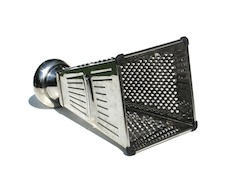 Reports of a third steel bolt falling from the 47-storey landmark Leadenhall Building in London, commonly known as “the Cheese Grater”, bring into sharp focus the unusual, and always headline grabbing, issues that accompany the new era of London skyscrapers, and their sometimes entirely literal impact on their surroundings.
Reports of a third steel bolt falling from the 47-storey landmark Leadenhall Building in London, commonly known as “the Cheese Grater”, bring into sharp focus the unusual, and always headline grabbing, issues that accompany the new era of London skyscrapers, and their sometimes entirely literal impact on their surroundings.
In this case, British Land announced that the issue has been attributed to “hydrogen embrittlement”, a fault in the manufacturing process of the bolts by which hydrogen atoms diffuse, combine, apply pressure and eventually break the metal. Two bolts had broken in November last year, with one plummeting to the ground below. The building has approximately 3,000 of these bolts, measuring just under a metre long each. Clearly, the risk of further failures raised an extremely alarming prospect, from a public liability perspective.
British Land confirmed that a number of bolts would be replaced as a precautionary measure and that the structural integrity of the building had not been affected. In a different context, the failures themselves are relatively inconsequential, but the risk of injury or damage given the sheer size, height and location of this building (let alone the attention it attracts) makes the issue one that has quite properly received swift and comprehensive attention.
Had any injury or damage occurred, the building’s owner would have had recourse to its public liability insurers in the first instance, but they in turn would look to pass on the liability through the appropriate contractual documentation.
If, as appears to be the case from British Land’s announcement, the fault arose during manufacturing (and there was no associated design or workmanship failure) there will most likely be a series of claims from the building’s owner to the main contractor and any subcontractor who, in turn, had contracted with the supplier. If the bolts were bespoke, and the faults are attributable to an error in their design, the relevant professional consultant’s (or manufacturer’s in house design team’s) professional indemnity insurance policy might ultimately respond.
It will be a long time before the “Walkie Talkie Building” (20 Fenchurch Street) is disassociated from the infamous occasion where its south facing concave façade concentrated the sun’s rays onto the street below and melted a Jaguar, causing over £1,000 worth of damage. After a hasty planning application, a brise soleil (solar shading) system has been installed.
Back in 2005, a window on the 28th floor of the Gherkin (30 St Mary Axe) fell off the building; the cost of new window opening devices and stainless steel fittings in this case were borne by the main contractor and curtain wall supplier.
These three very different examples all act as a timely reminder that any building (be it a major London skyscraper or a much more modest new development) will always have the propensity to have an impact on its immediate environment, after the construction process has finished, and building owners must always be alive to the public liability issues that may arise.
To mitigate these risks, building owners must ensure that (as well as carrying appropriate public liability insurance) they get the construction documents right and understand where responsibilities lie in dealing with any issues caused by their building.
All of the above examples would certainly have required careful investigation by an appropriate qualified expert to establish the technical cause (or causes) of the issue and steps necessary to remedy them. Instructing an expert on a joint basis to report back on agreed issues will very often de-limit the areas of dispute and enable a practical solution (be it temporary or permanent) to be expedited.
Placing an obligation in all of the relevant contracts / appointment documents to participate in appropriate dispute resolution procedures that would enable such investigations to take place on a sensible basis can prove an invaluable tool, and such provisions should be carefully drafted to take account where possible of particular aspects of the development in question.
Given such problems may only occur some time after completion, ensuring a comprehensive set of collateral warranties are in place to enable the developer to pursue a specialist subcontractor or design consultant for a particular aspect of the building is also invaluable, often avoiding time consuming multi party disputes and being a “get out of jail” card in the event that a party in the chain has become insolvent.
The Cheese Grater is not the first London skyscraper to experience unusual problems of this type, nor will it be the last. Its problems do, though, serve as a useful reminder of the potential implications of these types of post construction issues (whether arising from design, workmanship or faulty materials).
Chris Kirby-Turner is an Associate Solicitor in Thomson Snell & Passmore’s Construction & Engineering team.
Have you any commercial property events you'd like to tell us about? It could be networking, exhibitions, seminars, industry lunches or sporting fixtures. We will list them for free. Just email newsdesk@propnews.co.uk with the following details: Event name, date, time, venue, cost, booking info and a brief description of the event.
To list your property job vacancies on Property News. Email: richenda@propnews.co.uk.